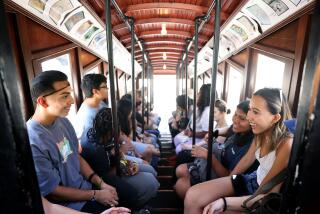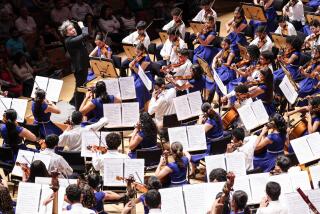A Festival of Learning : Soviet Youth, Jewish Students Hit It Off
With the American flag on the left and the Israeli flag on the right, a group of teen-agers from the Children’s Dance Company of Tbilisi cavorted across the auditorium stage at the San Diego Jewish Academy on Wednesday in one of the more unusual cultural meetings of the Soviet arts festival.
Given the unpleasant history of Jews in the Soviet Union, administrators at the Jewish school in La Jolla--kindergarten through ninth grade--had been somewhat apprehensive about the visit. Indeed, junior high teachers had discussed possible animosity concerning the visit with their classes beforehand, especially because several students are emigres from the Soviet Union who left under less than joyous circumstances.
But any worries turned out to be for naught. The fast-paced 45 minutes of dancing proceeded before a rapt audience, and was followed by animated conversation between the Georgian and Jewish children about things that teen-agers talk about anywhere: family, school, boys and girls.
The emigrant students themselves, with the ability to interpret directly between Russian and English, broke the ice during the post-dance reception, making the first approach to the initially shy dancers.
Thirteen-year-old Allen Berezovsky, himself only 10 months in the United States, found himself in the middle of one group of dancers and students, shooting questions in Russian and shouting back answers in English.
How many times have they been in the United States? (First time.) What do they think of our school? (They like it because it’s big.) How do they study? (With a special teacher who travels with them.)
“Yes, they are surprised we speak Russian,” Berezovsky said, surrounded by fellow emigres Felix Mikhalsky, Alex Shpigel and Mark Angert in the reception crush.
The dancers warmed to their hosts’ inquisitiveness. After one boy explained that he studies Arabic, a fellow dancer said “that (the boy’s) grade in the subject was very low,” to which the first dancer shot back, “You are a crazy guy!”
Another dancer, asked why there was only one girl among the troupe, joked, “It’s because we don’t like girls.” His twin brother laughed.
Academy teacher Arthur Zuckerman, although noting the ironies of having the dance troupe at the school, nevertheless said that “these are kids, and kids have to be taught to hate.”
Eighth-grader David Weiner said that those students familiar with current events in the Soviet Union did avoid potentially pointed questions out of deference to the performers. Angert, whose family arrived in San Diego only two months ago, said he would have liked to have talked at length about changes in the Soviet Union. Seventh-grader Sophy Weintraub kept to herself the fact that her uncle now in the United States was a “refusenik” for many years, losing his job and benefits in protest of his not being allowed to emigrate.
Mikhalsky greeted the dancers when they arrived, asking whether there were any Jews among them; there was one. Then the dancers asked if they were at a Jewish school. Mikhalsky said yes.
Raia Rechaim, a San Diego interpreter who accompanied the group, said dance leader David Agamerov and other officials made the same preparations for the visit to this school as for the three other San Diego-area schools they have already visited.
“I think today was interesting for them, especially to see a Jewish school,” she said.
More to Read
Sign up for Essential California
The most important California stories and recommendations in your inbox every morning.
You may occasionally receive promotional content from the Los Angeles Times.










